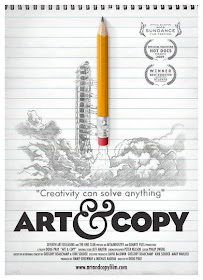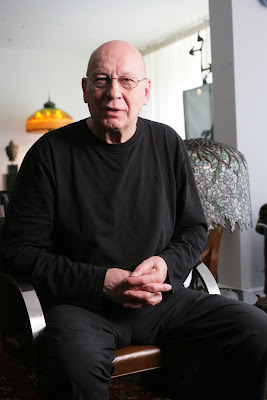
 I can't remember the last time a movie made me as angry as has ART & COPY, the new documentary about the adver-tising business and some of the talented people who, over the decades, have brought us a bevy of smart ads. The aging process, which gives us seniors an inordi-
I can't remember the last time a movie made me as angry as has ART & COPY, the new documentary about the adver-tising business and some of the talented people who, over the decades, have brought us a bevy of smart ads. The aging process, which gives us seniors an inordi-nate amount of crap to deal with,
has at least taught me one useful lesson: When I get very angry at a movie, chances are that this has more to do with me than with the film itself. Be-
cause Art & Copy has been made by Doug Pray, the man respon-
sible for one of my favorite documentaries -- Surfwise -- I looked forward to his new film with great anticipation. This can also make for a letdown when, as in this case, the film disappoints. All of which leads me to ask that you bear with me, while I try to coherently work out my ideas and feelings below. I'll try to be, if not brief, at least smart....
Mr. Pray's documentary (he's shown above) is a kind of paean to clever advertising and the men (mostly) and women (a couple of 'em, at least) who, over the last half-century, have given this country some of its better ads. (The movie doesn't get near the ads of Europe and Scandinavia, which to my mind have often done an even better job.) As it happens, TrustMovies has earned a good deal of his living from advertising over the decades, and so he does not come to the subject as a novice. He remembers first-hand those initial ads for Volkswagen that Pray makes much of in his movie. In the copywriting/design pool of which I was a part at Prentice Hall publishing -- yes, our bosses at PH were smart enough even back in the mid 60s to understand the idiocy of separating copy from design -- these VW ads were gospel. The surprising "Got Milk" campaign and even the earliest Tommy Hilfiger plugs (before anyone knew who the hell Mr. Hilfiger was; in fact, initially, we called him "Hillfinger") that Pray shows us in his film -- all of these struck me not just as old news, but news of ad campaigns that we have heard about again and again, over the years. And despite the relatively interesting interviews with "ad greats" George Lois (shown below), Mary Wells, Lee Clow and others, nothing particularly ground-breaking gets said.
 The press kits for Art & Copy begins with these words: Hate advertising? Make better ads. If only it were that easy. What if, rather than the ads themselves, it is what's behind the ads that is hated: The fact that reams of money are spent to create messages to brainwash the masses into feeling a need to purchase an unnecessary, sometimes harmful product -- and then reams more are spent buying media time and space to show these ads? This, the movie doesn't even come close to addressing. Even the film's hosannas to the Morning in America ads created by the late Hal Riney for the Ronald Reagan campaign (talk about a harmful product!) and how good they made people feel are countered only by another ad man's raised eyebrow and dismissive word, "Reagan." The press kits for Art & Copy begins with these words: Hate advertising? Make better ads. If only it were that easy. What if, rather than the ads themselves, it is what's behind the ads that is hated: The fact that reams of money are spent to create messages to brainwash the masses into feeling a need to purchase an unnecessary, sometimes harmful product -- and then reams more are spent buying media time and space to show these ads? This, the movie doesn't even come close to addressing. Even the film's hosannas to the Morning in America ads created by the late Hal Riney for the Ronald Reagan campaign (talk about a harmful product!) and how good they made people feel are countered only by another ad man's raised eyebrow and dismissive word, "Reagan." |
 |
 |
 |
 |
**********
So, how far off-base am I here? Is the above all about me and my prejudices? I'll be very interested in reading what others have to say about Art & Copy. Regarding Mr Pray's earlier doc, Surfwise: It opens up so many doors into the meaning of family, love, trust, abuse, sport, education, and alternative life styles -- then leaves us to make our own judgment. Has the filmmaker actually done the same thing here, but more subtly? After all, the film has gotten me to address much more than I initially thought it contained. Perhaps Pray is simply a master of stealth. I'd love to think so, but in this case, I kinda doubt it.... |
Art & Copy opens Friday August 21, in NYC (at the IFC Center),
and in Chicago, Denver and Seattle. You can find
the other specific theaters here.
(All photos are from Art & Copy -- or the making of it --
and in Chicago, Denver and Seattle. You can find
the other specific theaters here.
(All photos are from Art & Copy -- or the making of it --
and are courtesy of OutNowImageGallery)
No comments:
Post a Comment